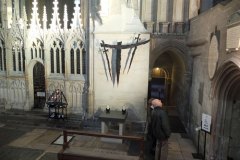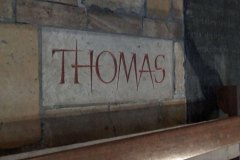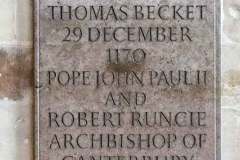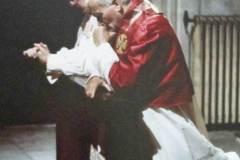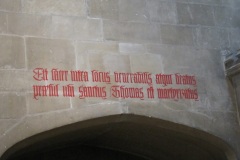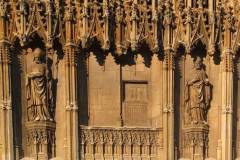This area in the north-west transept, known as the Martyrdom, provided one of the main stopping points for any medieval pilgrim visiting the shrine of St Thomas. It was here, on 29 December 1170, that four knights, each convinced he was carrying out the instructions of Henry II, slayed Thomas Becket, archbishop of Canterbury. The place of Thomas’ death is today marked by a stone bearing his name. The importance of the site was marked by the historic visit by Pope John Paul II on 29 May 1982, when the Pope knelt in prayer together with the head of the English Church, Archbishop Robert Runcie, at the site of Thomas’ death.
What to see (click on images below to enlarge and read captions):
- the dramatic new sculpture of the sword’s point – with its representation of four swords for the four knights (two metal swords with reddened tips and their two shadows) installed in 1986, the sculpture the work of Giles Blomfield of Truro (Image 1)
- the altar table itself was the first new altar in the cathedral for 448 years (Image 1)
- the stone denoting the spot where Becket was slain (Image 2)
- a wall tablet commemorates the papal visit in 1982, the first time a pontiff had ever visited Britain (Image 3) and the heads of the two churches at prayer (Image 4)
- the red lettered Latin inscription above the door leading to the cloisters which reads “The holy place within is where the blessed St Thomas was martyred”; this appeared originally on an internal wall between the cloister door and martyrdom site which has since been demolished (Image 5)
- for a very worn and damaged image of the original altar, see the central panel – between Lanfranc and Anselm – on the south-west porch external face; the broken sword point supposedly lies on the ground in front of the altar; the actual broken sword point was kept in a reliquary box (now long-lost) which gave the original altar its name (Image 6)
Sources: see standard cathedral sources
DL

